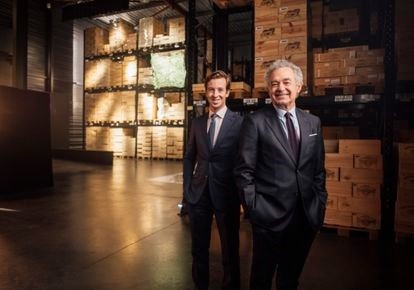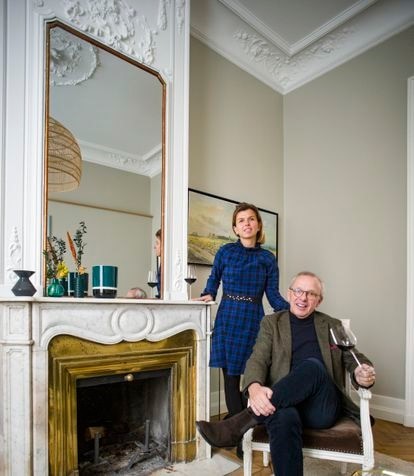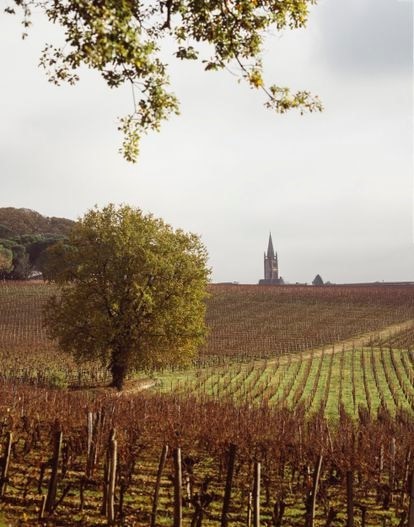Uncategorized
A trip to La Place de Bordeaux, the Wall Street of wine, with Telmo Rodríguez.
For four centuries it has been the place where the greatest wines of Bordeaux are sold. And in recent years, under its umbrella are also some of the most expensive and iconic non-French brands in the world. We visit some of the most powerful figures in a world of wineries, merchants and brokers spanning hundreds of years.
Four silver and crystal chandeliers in the centre of the table cast a soft, almost ghostly light over the delicate linen tablecloth. The crockery was engraved with the family coat of arms, and the cutlery was burnished like a mirror. Before each dinner, three glasses of wine: 1955, 1962 and 2019 vintages of Château Lafite, perhaps the most iconic estate on the planet. Baron Eric de Rothschild’s private dining room is draped in pastel colours, decorated with portraits of ancestors, and lacks electricity, as it did when the powerful line of bankers acquired it in 1868. The only lighting is provided by the lamps of the Second Empire furniture and shelves. Night falls. On a shelf rests a magnum (empty) of the 1975 vintage signed Juan Carlos I. The menu is light and very French.
The host is Jean-Guillaume Prats, 50, president of Château Lafite Rothschild, in Pauillac, an hour from Bordeaux. We are on the golden mile of wine, on the left bank of the Garonne, the most conservative and elitist. The right, with its capital in Saint-Émilion, is more minimalist and avant-garde: the cradle of “garage wines”. And just as expensive. Its latest record, 12 million euros per hectare of Château Beauséjour paid by the multinational Clarins. The most sought-after and imitated brands are born on the two margins, where demand always exceeds supply. Wineries without prices. The whim of billionaires and luxury holdings, and the gamble of banking, insurance and cosmetics groups. Something that “has dehumanised property and caused social problems”, criticises a socialist mayor of the region. Jewels of a unique land, climate and history, but also of speculation and marketing. In particular the only five châteaux (payments) classified in 1855 and 1973 as Premier Cru: Latour, Lafite, Margaux, Haut-Brion and Mouton Rothschild, which produce between 100,000 and 200,000 bottles depending on the vintage. These are the most coveted. We are at Lafite, one of the few still belonging to a family.
Pierre Antoine Casteja (right) and Jean-Quentin Prats in the Joanne company, with some of its six million bottles of top brands.
A tie is de rigueur. Prats, an elegant grey V República suit, Loro Piana coat and Berluti shoes, is part of the oldest wine aristocracy in Bordeaux. His father’s maternal family, the Ginestet, were powerful merchants and owners of Chateau Margaux (now owned by a family enriched by low-cost supermarkets); He worked at the Prats’ iconoclastic family winery, Cos d’Estournel (since 2000, owned by Michel Reybier’s hotel empire), before being one of the first to open a market in China, in the late 1990s, already then, for five years, in charge of the twenty global vineyards of LVMH (Moët Hennessy Louis Vuitton), the world’s largest luxury conglomerate. Prats landed on the Left Bank again in 2017, signed by this branch of the Rothschilds (one of three that make wine). And he is about to leave the presidency of Lafite, whose reins will be taken by Saskia de Rothschild, 34, the only daughter of the baron, a journalist by training, whose mission is to bring this estate (about 100 hectares of vines) up to date.de 1234 and take up the challenge of organic farming and climate change without affecting the essences of the house. A delicate balance. A bottle of the latest Lafite vintage (the 2019 vintage) is quoted on the international market remotely from Wall Street in Bordeaux above 1,000 euros.
Jean-Guillaume has invited Spanish winemaker Telmo Rodríguez, his childhood friend and wanderer in the Riojan estate of Remelluri, to dine in the privacy of this home, and the two journalists. The reason is to celebrate the entry of Telmo and his latest wine, the red Yjar, into the Place de Bordeaux, which for a winemaker means being promoted into the world’s wine leagues. He is the first Spaniard to gain access to the sophisticated global marketing system devised in Bordeaux four centuries ago, which reaches 186 countries in a capillary and segmented way. And without exception they use all the great chateaux of the region (no more than 200 of the 8,000 existing brands, which contribute only 4% of the volume, but account for 20% of the turnover). And to which some of the world’s most renowned wineries outside Bordeaux have also been added with a trickle since 1998.
Nearly 90 international wines are already under the logistical, commercial and image umbrella of La Place; their style is Bordeaux, but they bring modernity and dynamism to Bordeaux. The price does not go below 100 euros and in some cases it is close to 1,000 (like Masseto). More than half are Italians (mostly Tuscans) and Americans (mostly Californians), but there are also Australians, South Africans, Argentines and Chileans. And a Spaniard. A strategy that implies for a wine, beyond the commercial, an additional credibility, notoriety and recognition. And the possibility of reaching all the starred restaurants, the best shops and reaching the hands of connoisseurs. Wherever they are. And even to aspire to Christie’s or Sotheby’s auctions.
François Lévêque is one of the five most respected courtiers (intermediaries) of the hundred or so ‘La Place’. He only works with great wines. Together with his daughter Caroline Lévêque, the fifth generation of the family in the business, he has turned to a website that acts as an intermediary between winemakers and wholesalers.
On 16 September, Telmo Rodríguez sold the 7,200 bottles of his red Yjar at 120 euros around the world in 15 minutes, via seven Bordeaux merchants who allocated them to their global network by e-mail. “And he could have sold 50,000, because there was demand; connoisseurs from Hong Kong to New York to Zurich want something new; the more you know, the more you want to try different wines, reflecting a terroir, a climate and a few grape varieties, and you’re willing to pay for it. This is the trend, and this business is left to La Place,” explains François Passaga, the major importer of French wines in Spain.
That September morning represented the end of a road for Telmo. The one that began 10 years ago, when, at the head of Remelluri, his payment in Rioja Alavesa, one of the most beautiful in Spain, bordering Labastida, with roots in the 12th century, in which wine has been made at least since In 1420 and his father resurrected in the sixties, he decided to make a wine only with grapes from a 3.8 hectare plot anchored in the limestone slope of the Sierra de Toloño. I wanted to concentrate that landscape and tradition in every bottle.
“We gave it a lot of turns. To get into Bordeaux, Pablo Eguzkiza, my partner since 1987, and I had to create a wine that would make people dream. And few Spanish wines have this effect, perhaps only Vega Sicilia. What we had done since 1971 in Remelluri was not valid for La Place, which is accessed by magic and pedigree; we had to make a different wine, from the village, which spoke of our land and had a legend to tell. Only then do you have access to the Bordeaux ecosystem. We started in 2010 to investigate our terroir, to analyse it, to observe the vegetation, to do microvinifications. Until we had a barrel with the best we could give. And it was tasted by the number one Bordeaux business. And they said, “Go ahead. Today, only seven of La Place’s largest merchants distribute Yjar worldwide, with a quota of less than 1,000 bottles each.”
“What was your objective?” To make money, to gain prestige?
– To show that Spanish wines are among the best in the world. That the next revolution will be in our vineyards. I have opened the door. Now it’s up to the rest of the winemakers to do things consistently. It is not logical that on the Place de Bordeaux there are 30 Italians and only one Spaniard. They are waiting for us. Moreover, being in Bordeaux gives category to your whole project. It is a sounding board, the hinge of great wine, whatever the country.
Château Angelus is one of the most expensive wines on the right bank of the Garonne. James Bond’s wine in one of his films. In the background, the mythical wine-growing capital of Saint-Émilion.
Jean-Guillaume Prats tasted the 1955 Lafite, wiped himself with a starched napkin, reflected and pronounced: “It is alive, better than when it was born. This is the category of a great wine: its ability to age, to transcend time. And that’s been the Bordeaux model.” Why is it the epicentre of wine? “It’s different from everything else. It has had an influence and an outside presence for hundreds of years. In the 16th and 17th centuries, it was Dutch and German merchants; in the 19th century, British bankers, and for the past 30 years, luxury entrepreneurs, who have given us a dimension of exclusivity, detail, long-term vision and customer service. But in Bordeaux there have always been new ideas, new capital and new ambitions.
And one big captive market, the British. And no wine region has counted on that. And you add that it’s a region of high quality wines and also high quantity (700 million bottles); and that it’s easy to drink and store. And also, thanks to the commercial system of La Place, which is a very careful distribution, they reach all the corners, for which they are known all over the world.The dinner in Lafite is the first stage of our journey from Labastida (Rioja Alavesa) to Bordeaux. A journey that the winemaker and cleric from Alava, Manuel Quintano, made in 1785 to learn how to make “modern wines” from Bordeaux, which he applied in Rioja from 1787. Or the Marquis of Riscal in 1860, who recruited the French winemaker Jean Pineau (whose descendants we will visit at Chateau Lanessan) with the aim of making Bordeaux wines on his Riojan estate. A century and a half later, Telmo Rodríguez is following suit.The place of Bordeaux is not a place, it is a system. Although, if you want to look for a setting, it would be the Place de la Bourse, where the majestic buildings of the Stock Exchange, the Customs House and the Chamber of Commerce stand next to the banks of the Garonne, from whose quays barrels of Bordeaux wine were shipped to Antwerp, Hamburg, England and, from there, the whole world.
The La Place system is made up of three players: the châteaux (wineries), who only produce wine and do not have a sales department; the négociants (retailers), who buy it, store it and circulate it through their network of importers and distributors around the world; and the courtiers (brokers), who act as intermediaries between the winegrowers and the négociants and certify the transactions. A model that has its crucial moment every April, during the en primeur sale (for the first time), when these négociants taste in each prestigious château the wines that are still in barrels, recently blended, barely finished and unaged from the previous September’s harvest. They study them. They reflect. And they buy in the future. Like in the commodities market. They will be delivered to them almost two years later in bottle, but they are obliged to pay a third on the spot, another after six months and the last on delivery. If the merchants renounce their quota in a year of bad harvest for certain châteaux, they lose their quota for the following years. Here, betrayal is not forgiven. And the handshake is revered. And the better and more carefully they distribute their wines around the world, the more quotas they will obtain from the great winegrowers in the following years.
Brokers Jeremy Quievre, left, of Excellence Vin, and Laurent Quancard, one of the most prestigious courtiers, specialising in great foreign wines these days, at their headquarters in Bordeaux.
En primeur sales imply a cash advance for the wineries. And for the merchants, to secure a quota of great wines at a certain price (the cheapest they are supposed to have ever had) which will ensure them a profit margin of between 15 and 18%. Depending on their prestige and the quantity and quality of their sales network, each of the négociants can obtain between 1,000 and 10,000 bottles of grands crus. Later, moreover, each of them will be free to speculate on the secondary market with the limited units of the grands crus that they have kept or obtained from other merchants or collectors.
The quantity of wine that each château launches for the first time through different tranches is confidential and can range from 50 to 90% of its vintage. The rest of its stocks (inventories) are used as “safety reserves” and also to launch them from time to time in order to animate the market (as in the stock market) or to speculate on old vintages, which are very fashionable among the great wine addicts. Selling en primeur is a gamble. Heated (like stocks) by the notes of gurus (like Robert Parker) and world journalists (like Jane Anson or Jancis Robinson). It’s the Fashion Week of luxury wine. “And with the Brexit and the consequent decline of London as one of the world’s wine trade centres, Bordeaux’s position is further strengthened,” says British journalist Jane Anson.
The other key date for La Place is September, the launch date for the great non-Bordeaux wines it is responsible for marketing. Both processes, the en primeur sale and the global wine offering, culminate on the same day with the setting of the price at which the winemakers sell each bottle to the négociants. The grey brains behind this decision are the intermediaries, the courtiers (a profession that dates back to 1321), who have to gather all the data on the harvest, its quantity and quality, the price of previous years, whether the wine should be fruitier (to the taste of the Asian public, which accounts for more than a third of sales) or mineral (to the taste of the Anglo-Saxon public; the United States is the second largest importer). And, above all, the global socio-economic situation. Whether the Chinese market (which has been key since 2008) is rather open or closed; in case of economic crisis or expansion. It’s like a stock market price,” explains courtier François Lévêque, “if you set the starting price too high, the market stalls. The wine has to circulate and be sold. If you put it at a realistic price, the normal thing is that it goes up. You can win, but in the long run. The courtiers charge 2% of each transaction (paid by the dealers) and are forbidden to buy on their behalf. “We are the intermediaries between the producers and the dealers.”
It all happens in France over a tablecloth and a bottle of wine. Lévêque, tweed suit jacket and exquisite manners, one of the five most respected courtiers of the 100 accredited to La Place, and who only works with grands crus, uncorks two in his elegant little hotel in the centre of Bordeaux: a 2003 Château Léoville Las Cases and a Mission Haut-Brion from the same year. “You work with the great Bordeaux producers through trust and personal relationships. And this is done over centuries,” he says. A chef’s son prepares lunch. His daughter Caroline, a fifth-generation Lévêque, serves champagne. She is one of the two courtiers and is revolutionising the trade. On the one hand, it serves as a gateway for foreign wines to find their way to La Place; she has also developed a website to mediate between the cellars and wholesalers and their respective stocks, and is very active in the market for older wines of great vintages, which are now the gold mine.
The warehouse of the Joanne wine company, just outside Bordeaux. The company has six million bottles of legendary brands stored at 16º and with its own Fort Knox security.
A courtier needs to know where the best bottles are, who owns them, whether he is prepared to sell them and at what price. You must have all the information. Quietly. Intimate with the chateau owners, they travel the region throughout the year observing the vineyards and tasting; listening and sniffing; assessing the harvest and playing a key role in setting the price and quotas each dealer receives. They are behind every step that is taken at La Place. They even act as an intermediary between the wholesalers behind the scenes. 99% of the large transactions of prestigious châteaux go through them. Even the purchase of cellars by major investors and the valuation of their stocks. They are able to identify counterfeit wines. Their figures are regulated by law and are accessible by opposition. They are the ones who advise the estimate.
The doors of La Place were opened to Telmo Rodríguez by another great courtier, Laurent Quancard. Middle-aged, in a bespoke anthracite suit and English shoes with buckles, he is hosting a reception at the Napoleonic Palace where he has his office. Assisted by the young Jeremy Quievre as the person in charge of driving and moving foreign wines to La Place (such as Telmo Rodríguez’s Yjar) within the Excellence Vin company, his profile is more that of a stockbroker than a fellow Girondin. “A courtier must have business intelligence. To offer a good service in a global and open market. Approximate opposing interests, those of supply and demand. And know where the stocks are. We have gone from being mere middlemen to advisors. We help foreign wines coming to Bordeaux to position themselves and we accompany them on the market through marketing and communication. Having control over the distribution of these legendary wines around the world has been vital to Bordeaux’s survival, it makes it sexier; otherwise New York or Hong Kong would have kept it.
“Who rules Bordeaux wine?
– First it was the aristocrats; then the merchants, who had money, knew English, carried the wine and made big payments. But since JFK made Bordeaux wine fashionable in America in the 1960s [Petrus was his favourite wine], the brands became more coveted and expensive. From the 1980s onwards, the luxury groups came in. And they made big investments without haste. And since then, they have been in charge. Bernard Arnault [LVMH] owns Château d’Yquem and Château Cheval Blanc; François Pinault [of the Kering group, also owner of Gucci] owns Château Latour, and the Wertheimer brothers [owners of Chanel], Château Canon and Château Rauzan-Ségla. Today at La Place.
Jacques Bouteiller, Mitglied der Familie, die den Wein Château Lanessan besitzt, grenzt an den Palast, der dem Weingut vorsteht. Dieser Weinkeller war eng mit den modernen Rioja-Weinen aus dem Jahr 1860 verbundenEine Sache, die für Nicolas Audebert, den Direktor der Chanel-Weingüter, klar ist. Audebert, der bereits für LVMH in dessen Champagnerhaus Krug gearbeitet hat, empfängt auf dem Weingut Rauzan-Ségla in Margaux. Sein Image ist cool: Pullover aus Andenwolle, Designerjeans, Timberland-Stiefel; sogar die zart bukolische Einrichtung seines Büros riecht nach Geld. Audebert sitzt auf dem Parkett neben dem Kamin und erklärt das Zeichen von Chanel auf seinem Weingut: “Ein luxuriöses Familienunternehmen ist niemandem Rechenschaft schuldig; es macht die Dinge mit der höchsten Qualität, ohne die Spannungen der Dividende. Dies ist kein Chanel-Wein; Es ist ein Luxuswein aufgrund des Muskels der Familie Wertheimer und unserer Arbeit, ihn herzustellen. Das große, sichere Schiff in Fort Knox, in dem der Geschäftsmann Pierre-Antoine Castéja die meisten der legendären sechs Millionen Flaschen seiner Firma Joanne bei 16 Grad Celsius hegt und pflegt, hat etwas von einem New Yorker Modeclub. Riesige, bis zur Decke reichende Regale enthalten Tausende von Holzkisten, die mit den besten Marken auf dem Markt etikettiert sind. Verkauft vier Millionen pro Jahr. Das Licht ist gefiltert, es gibt riesige Fotografien an den Wänden, einige Kunstinstallationen, die dem Händler gehören, und einen großen Kristallleuchter. Das Unternehmen wurde 1865 von seiner Familie gegründet. Heute ist es die Nummer eins in den USA und eines der mächtigsten Unternehmen in China. Allein in New York bedient sein Netzwerk die 600 besten Restaurants der Stadt.Auf dem Place de Bordeaux gibt es etwa 300 dieser Händler. Zwischen 40 erwirtschaften sie einen Umsatz von 2.000 Millionen Euro und versorgen ein Netzwerk von 10.000 Qualitätshändlern in der ganzen Welt. Und sie stärken ihre globale Position, indem sie große Weine außerhalb von Bordeaux vermarkten. Castéja hat bereits eine neue Tochtergesellschaft gegründet, die sich diesen Labels widmet und Joanne Rare Wines heißt. Sie wird von dem Weinhändler in den Zwanzigern Jean-Quentin Prats geleitet, der aus der Saga Prats et Ginestet stammt und wie ein junger Wolf der Cité aussieht. Der Geschäftsmann Castéja -der drei Juwelen eröffnet, einen Margaux von 1996, einen Léoville Las Cases von 2001 und einen Château d’Yquem von 2016-, 69 Jahre alt, makelloser schwarzer Anzug und Krawatte aus Hermès-Strick, hat heute Abend keine Lust, über Geschäfte zu sprechen. Er spricht lieber über Kunst und die Gerichte seines Freundes, des Chefkochs Martín Berasategui. “Wir bei Joanne sind Handwerker im Einzelhandel. 75% unserer Kunden kaufen bei uns weniger als 23 Flaschen. Wir sind ein Lebensmittelhändler. Und es ist immer noch Bordeaux, eine einzigartige Mischung aus Tradition und Moderne”.Brot und Käse in Saint-Émilion. Und dann die Fahrt. Die Rückfahrt erfolgt in einem Regenschauer zwischen Bordeaux und der Rioja Alavesa. Das Meer wird links liegen gelassen. Die Rioja zeichnet sich ab. Und Telmo Rodríguez plant den nächsten Coup.
Jean-Guillaume Prats, stehend, eine der mächtigsten Persönlichkeiten in der Welt des Weins, der für die Rothschilds und LVMH gearbeitet hat, mit dem riojanischen Winzer Telmo Rodriguez auf dem Place de la Bourse in Bordeaux.





